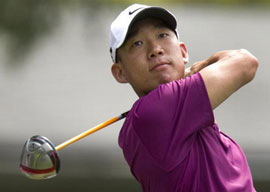
August 28, 2013

Anthony Kim
BYU economist Joseph Price provided Epstein with some intriguing data on NBA players:
…the average white American NBA player was 6’7.5” with a wingspan of 6’10.” The average African-American NBA player was 6’5.5” with 6’11” wingspan; shorter but longer.
Epstein adds that the average African American in the NBA can jump 29.6” versus 27.3” for whites. Combined with the extra inch of reach, that helps explain the preponderance of blacks in a game where the single most important metric is how high in the air you can get your hand. One scientist told Epstein, “So maybe it’s not so much that white men can’t jump. White men just can’t reach high.”
Baseball hitters are generally large men, but in contrast to lanky NBA players, they tend to have physiques less likely to stand out in crowds. What’s the ballplayers’ physical secret?
Eyesight. The ability to see the rapidly rotating red seams of the baseball as it leaves the pitcher’s fingertips is crucial to hitting. The Los Angeles Dodgers employed a team ophthalmologist who had to construct his own ultra-hard eye charts to test hitters’ vision because the team was, literally, off the commercial charts. “Half the guys on the Dodgers’ major league roster were 20/10 uncorrected.”
Finally, if you are a Tiger Father dreaming of your progeny surpassing your sporting achievements, when should you insist your child specialize in one sport?
Not too young. A study of 243 Danish athletes in sports that are measured in “centimeters, grams, or seconds” (such as swimming, weightlifting, or track and field) found that burnout is a sizable threat. The most successful don’t start specializing until after age 15. Until their late teens, contra the 10,000 Hour Rule, they have fewer cumulative hours of practice than the future also-rans.
In other words, let your kid play normal schoolyard sports such as soccer or basketball for a long time before picking a specialty. The more obscure sports tend to be boring for children, so don’t make play an ordeal.
Obviously, this Danish finding, like almost all of Epstein’s book, is commonsensical. This lack of counterintuitive Gladwellian advice will no doubt limit the author’s success on the public-speaking circuit. But it may prevent a few unhappy childhoods.
One sport that Epstein doesn’t tackle in depth is golf. A true believer in Gladwell’s 10,000 Hour Rule is a 33-year-old Portland photographer named Dan McLaughlin, who had never played a round of golf in his life before quitting his job in 2010 to put in 10,000 hours of direct golf practice in hopes of becoming a touring pro.
He’s now 4,437 hours into his odyssey, most of it spent diligently on the practice tee rather than playing. He first played 18 holes in 2011 and by August 2012, McLaughlin was down to a handicap of only 6.5, which is better than the vast majority of recreational golfers. Unfortunately, diminishing marginal returns have set in, and he’s only pared 0.6 strokes off his handicap over the last twelve months.
Waiting until age 30 to start golfing may have thwarted this admirably self-disciplined man’s dreams. Numerous outstanding athletes from team sports have retired to the golf course, but only 49er quarterback John Brodie has ever won on the pro senior tour. (Strikingly, washed-up football players have had far more success as actors than as golfers.)
Because it’s hard to start golf late, East Asian Tiger Parents have been thrusting their infants onto the practice tee. They’ve fetishized golf since the half-Asian Tiger Woods became famous as a teen in the 1990s. So far, East Asians have rapidly taken over ladies’ professional golf, because golf hasn’t been fashionable with Western women, at least not since the Fairway Flappers of The Great Gatsby era. But Asians haven’t yet stood out on the men’s tour.
Among Asian-American golfers, the two most celebrated Tiger Cubs of the last decade, Michelle Wie and Anthony Kim, may have been damaged by their pressurized upbringings. Nine years ago, Wie might have been the best 14-year-old golfer in the world, male or female. But then, apparently, estrogen kicked in. This year, she made only two top tens on the LPGA tour.
Following an intense Korean-American childhood hitting countless golf balls at the driving range down the block from me, Kim was sixth on the 2008 PGA money list at age 22. But now, battling physical and emotional problems, he hasn’t been seen on tour since June 2012.
Back in 1850, the French economist Frédéric Bastiat wrote That Which is Seen, and That Which is Not Seen. That’s a useful title to bear in mind. When Kim was on TV winning golf tournaments, he was living proof of the 10,000 Hour Rule. But out of sight is out of mind.
Some remember him, though. When other Korean parents ask Kim’s parents how to raise a golf star, they now reply, “Don’t try.”